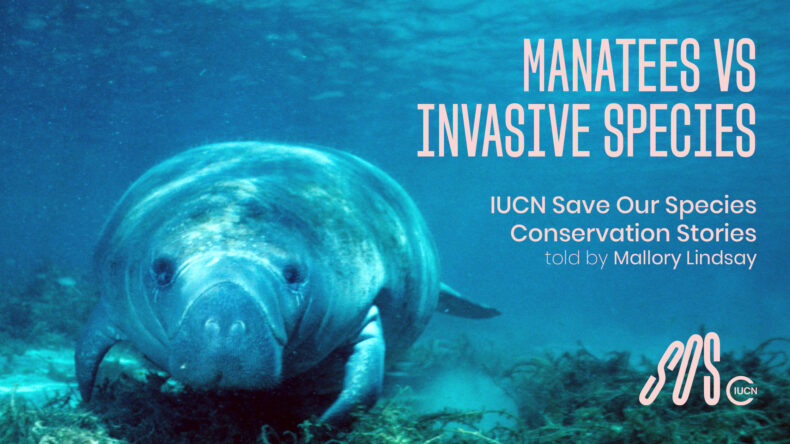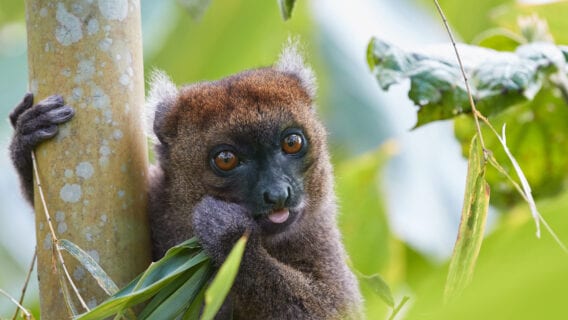Manatees vs. Invasive Species – Part One

Manatees are an integral part of aquatic ecosystems and yet, they are threatened with extinction. Located thousands of kilometers apart, two different manatee species face very similar problems that are being dealt with in very different ways. Being big and beautiful aren’t the only things the Florida manatee and the African manatee have in common.
Both their livelihoods are being threatened by photosynthesizing invaders.
Manatees play an important role in maintaining a healthy coastal environment. When manatees feed on rooted aquatic plants, including seagrasses, their trimming of the grass blades stimulates new growth, which contributes to the overall health of the seagrass beds and other species that inhabit them. Manatees also eat floating vegetation that might otherwise block canals.
While manatees are primarily herbivores— consuming 4%-9% of their body weight each day in wet plant matter— some ‘plants’ aren’t on the menu. In fact, some chloroplast carrying species are causing big problems for these gentle giants and making scientists worry.
In the United States, Central Florida’s Indian River Lagoon — a 150-mile-long saltwater estuary and Florida manatee population stronghold—has lost more than 90% of its seagrass within the last decade. Seagrass is the Florida manatees’ main food source.
Freshwater and brackish algae species floating at the surface the water— some even producing harmful toxins— are outcompeting the seagrass for sunlight and nutrients, leaving the once lush beds now barren. Although naturally occurring and part of a balanced ecosystem, these plant-like algae are increasingly becoming out of control due to human impact and negligence. According to U.S. wildlife authorities, 2021 resulted in record number of manatee deaths due to starvation.
As part of IUCN Save Our Species’ SOS African Wildlife initiative, co-funded by the European Union, a project is dealing with similar problems at the opposite side of the world. Located in Littoral, Cameroon, Lake Ossa is a 4000-ha wildlife reserve well-known for its important population of African manatee— a species classified as Vulnerable on the IUCN Red List of Threatened Species.
Like the beloved Florida manatees, the African manatees in Lake Ossa face a cornucopia of threats: boat propellers, habitat loss, human encroachment, and their own green invaders. . .
The invasive giant salvinia.
In addition to being unappealing to the African manatee, this free-floating fern blocks out essential sunlight and depletes the lake’s waters of vital nutrients— preventing the manatees’ true food source (antelope grass) to thrive.
Doubling in size every 7 to 10 days, the proliferation of the invasive weed is having a serious impact on the local fishing community as well. Depleting the lake of essential oxygen, fish populations are dwindling and the local economy is being affected. Market price of fish has doubled due to scarcity and is becoming less affordable to so many.
While scientists and conservation groups on both fronts are coming together to save their local manatees, the approaches are quite different. U.S. agencies and sirenian scientists are currently providing supplemental food plots for the Florida manatees while solutions for mitigating the algae blooms are being figured out.
In Cameroon, the members of African Marine Mammal Conservation Organization (AMMCO) and partners have tried many solutions in the past, but none have provided permanent relief from the fast-reproducing, floating fern.
However, another approach— called biocontrol— was introduced to help save Lake Ossa’s manatees.
Biocontrol is a method of controlling invasive species by utilizing their own enemies against them. In the case of the giant Salvinia, it would be a tiny South American creature known as the Salvinia weevil
Although it seems outlandish that a two-millimeter weevil can save a 4.5 m (15 ft) manatee, the research is there and the story is remarkable.
**Because the weevil introduction will require a complicated, multi-phase approach (with lots of fascinating details), we will be covering the story in two parts. Stay tuned for the next sections covering the delivery, rearing, and results of the manatee saving salvinia weevil.
The contents of this publication are the sole responsibility of Mallory Lindsay and do not necessarily reflect the views of IUCN or the European Union.

About Mallory Lindsay (AKA the Curious Conservationist)
Mallory travels near and far to share the stories of wild & weird creatures, highlight citizen-science wildlife projects, and help grassroot conservation groups connect with local communities. Her mission is to spark curiosity about the natural world while empowering others to do the same through public outreach, education development, and citizen science initiatives. Find out more on her official website.




